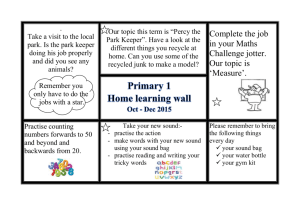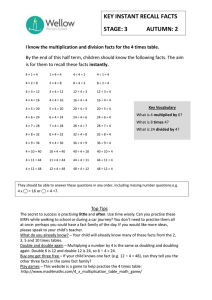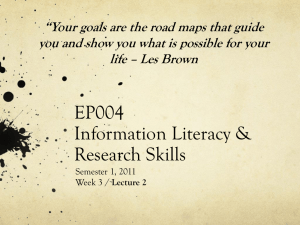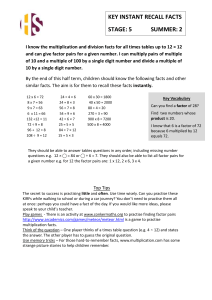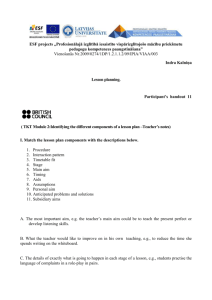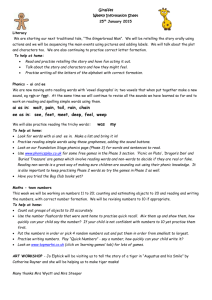Unit Planner Appendix
advertisement
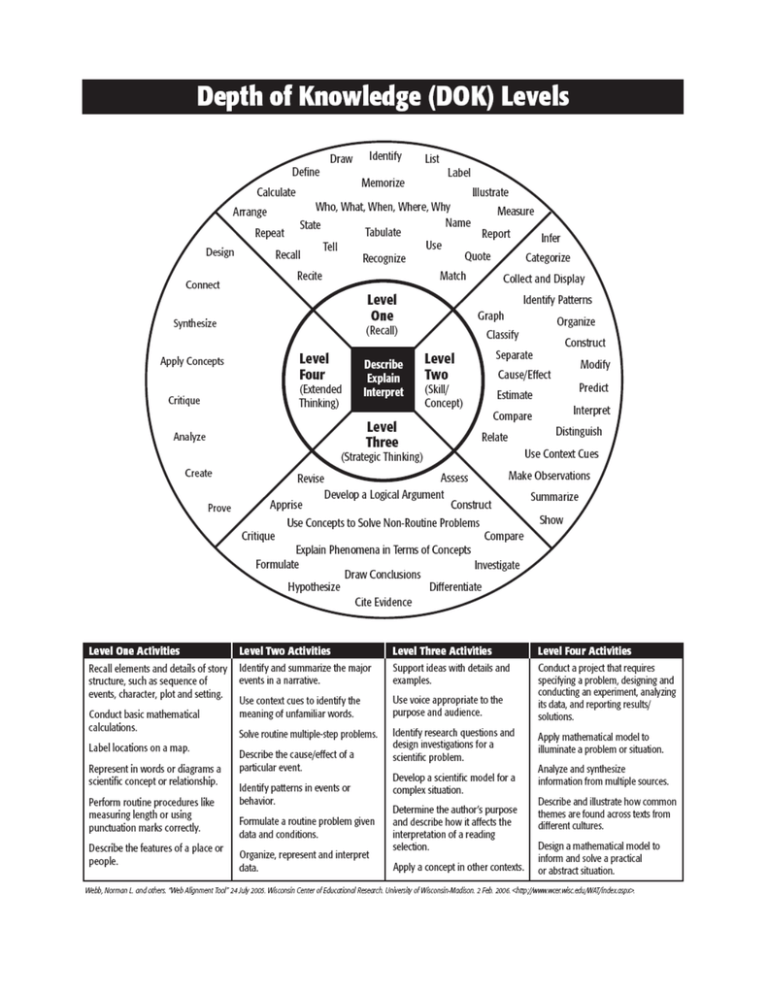
ATL Skill Indicators: Page 1 Communication: Give and receive meaningful feedback Use intercultural understanding to interpret communication Use variety speaking techniques to comm. w/ a variety of audiences Use appropriate forms of writing for diff. purposes and audiences Use a variety of media to communicate with a range of audiences Interpret and use effectively modes of non-verbal communication Negotiate ideas and knowledge with peers and teachers Participate in, and contribute to, digital social media networks Collaborate with peers & experts using variety digital environ. and media Share ideas with multiple audiences using variety digital environment/media Read critically and for comprehension Read a variety of sources for information and for pleasure Make inferences and draw conclusions Use and interpret a range of discipline-specific terms and symbols Write for different purposes Understand and use mathematical notation Paraphrase accurately and concisely Preview and skim texts to build understanding Take effective notes in class Make effective summary notes for studying Use a variety of organizers for academic writing tasks Find info for inquiries, using a variety of media Organize and depict information logically Structure information in summaries, essays and reports Collaboration: Use social media networks to build and develop relationships Practise empathy Delegate and share responsibility for decision-making Help others to succeed Take responsibility for one’s own actions Manage and resolve conflict, and work collaboratively in teams Build consensus Make fair and equitable decisions Listen actively to other perspectives and ideas Negotiate effectively Encourage others to contribute Exercise leadership and take on a variety of roles within groups Give and receive meaningful feedback Advocate for one’s own rights and needs Information Literacy: Collect, record and verify data Access information to be informed and inform others Make connections between various sources of information Understand benefits/limitations of personal sensory learning preferences when accessing/processing/recalling information Use memory techniques to develop long-term memory Present information in a variety of formats and platforms Collect & analyse data to identify solutions & make informed decisions Process data and report results Evaluate and select information sources and digital tools based on their appropriateness to specific tasks Understand and use technology systems Use critical-literacy skills to analyse and interpret media communications Understand and implement intellectual property rights Create references and citations, use footnotes/endnotes and construct a bibliography according to recognized conventions Identify primary and secondary sources Media Literacy: Locate, organize, analyse, evaluate, synthesize and ethically use info. from variety of sources and media (including digital social media and online networks) Demonstrate awareness of media interpretations of events and ideas (including digital social media) Make informed choices about personal viewing experiences Understand impact of media representations and modes of presentation Seek a range of perspectives from multiple and varied sources Communicate information and ideas effectively to multiple audiences using a variety of media and formats Compare/contrast & draw connections btw (multi)media resources Organization: Plan short- and long-term assignments; meet deadlines Create plans to prep for assessments (exams and perform.) Keep and use a weekly planner for HW Set goals that are challenging & realistic Plan strategies/take action for personal and academic goals Bring necessary equip. & supplies to class Keep organized and logical system of info files/notebooks Use appropriate strategies for organizing complex info Understand and use learning styles Select and use technology effectively and productively ATL Skill Indicators: Page 2 Critical Thinking: Practise observing carefully in order to recognize problems Gather and organize relevant information to formulate an argument Recognize unstated assumptions and bias Interpret data Evaluate evidence and arguments Recognize and evaluate propositions Draw reasonable conclusions and generalizations Test generalizations and conclusions Revise understanding based on new information and evidence Evaluate and manage risk Formulate factual, topical, conceptual and debatable questions Consider ideas from mult. perspectives Develop contrary arguments Analyse complex concepts and projects into their constituent parts and synthesize them to create new understanding Propose & evaluate a variety of solutions Identify obstacles and challenges Use models and simulations to explore complex systems and issues Identify trends and forecast possibilities Troubleshoot systems and applications Creative Thinking: Use brainstorming and visual diagrams to generate new ideas and inquiries Consider mult. alternatives, including unlikely or impossible Create new solutions to authentic prob. Make unexpected or unusual connections btw objects and/or ideas Design improvements to existing machines, media and technologies Design new machines, media and technologies Make guesses, ask “what if” questions and generate testable hypotheses Apply existing knowledge to generate new ideas, products or processes Create original works and ideas; use existing works and ideas in new ways Practise flexible thinking—develop multiple opposing, contradictory and complementary arguments Visible thinking strategies & techniques Generate metaphors and analogies Transfer: Use effective learning strategies in subject groups and disciplines Apply skills/know. in unfamiliar situations Inquire diff. contexts to gain a diff. POV Compare conceptual understanding across multiple disciplines Make connections between subject groups and disciplines Combine knowledge, understanding and skills to create products or solutions Transfer current knowledge to learning of new technologies Change the context of an inquiry to gain different perspectives Reflection: Develop new skills, techniques and strategies for effective learning Identify strengths and weaknesses of personal learning strategies (self-assessment) Demonstrate flexibility in the selection and use of learning strategies Try new ATL skills and evaluate their effectiveness Consider content – What did I learn about today? – What don’t I yet understand? – What questions do I have now? Consider ATL skills development – What can I already do? – How can I share my skills to help peers who need more practice? – What will I work on next? Consider personal learning strategies – What can I do to become a more efficient and effective learner? – How can I become more flexible in my choice of learning strategies? – What factors are important for helping me learn well? Focus on the process of creating by imitating the work of others Consider ethical, cultural and environmental implications Keep a journal to record reflections Affective: Mindfulness – Practise focus and concentration – Practise strat. to develop mental focus – Practise strat. to overcome distractions – Practise awareness of body–mind connections Perseverance – Demonstrate persistence and perseverance – Practise delaying gratification Emotional management – Practise strategies to overcome impulsiveness and anger – Practise strategies to prevent and eliminate bullying – Practise strat. to reduce stress & anxiety Self-motivation – Practise analysing and attributing causes for failure – Practise managing self-talk – Practise positive thinking Resilience – Practise bouncing back after adversity/mistakes/failures – Practise “failing well” – Practise dealing with unmet expectations Practise dealing with change Key Concepts: (pick only one) Aesthetics deals with the characteristics, creation, meaning and perception of beauty and taste. The study of aesthetics develops skills for the critical appreciation and analysis of art, culture and nature. Communication is the exchange or transfer of signals, facts, ideas and symbols. It requires a sender, a message and an intended receiver. Communication involves the activity of conveying information or meaning. Effective communication requires a common 'language' (which may be written, spoken or non-verbal). Connections are links, bonds and relationships among people, objects, organisms or ideas. Culture encompasses a range of learned and shared beliefs, values, interests, attitudes, products, ways of knowing and patterns of behaviour created by human communities. The concept of culture is dynamic and organic. Form is the shape and underlying structure of an entity or piece of work, including its organization, essential nature and external appearance. Identity is the state or fact of being the same. It refers to the particular features which define individuals, groups, things, eras, places, symbols and styles. Identity can be observed, or it can be constructed, asserted, and shaped by external and internal influences. Perspective is the position from which we observe situations, objects, facts, ideas and opinions. Perspective may be associated with individuals, groups, cultures or disciplines. Different perspectives often lead to multiple representations and interpretations. Systems are sets of interacting or interdependent components. Systems provide structure and order in human, natural and built environments. Systems can be static or dynamic, simple or complex. Change is a conversion, transformation, or movement from one form, state or value to another. Inquiry into the concept of change involves understanding and evaluating causes, processes and consequences. Communities are groups that exist in proximity defined by space, time or relationship. Communities include, for example, groups of people sharing particular characteristics, beliefs or values as well as groups of interdependent organisms living together in a specific habitat. Creativity is the process or ability to make or produce something new and original, often characterized by the use of imagination or divergent thinking. It may be evident in the process as well as the outcome, solution or product. Development is the act or process of growth, progress or evolution, sometimes through iterative improvements. Global interaction focuses on the connections among individuals and communities, as well as their relationships with built and natural environments, from the perspective of the world as a whole. Logic is a method of reasoning and a system of principles used to build arguments and reach conclusions. Relationships are the connections and associations between properties, objects, people and ideas-including the human community's connections with the world in which we live. Any change in relationship brings consequences-some of which may occur on a small scale, while others may be far reaching, affecting large networks and systems like human societies and the planetary ecosystem. Time, place and space The intrinsically-linked concept of time, space and place refers to the absolute or relative position of people, objects and ideas. 'Time, place and space' focuses on how we construct and use our understanding of location (“where” and “when”). IB Assessment Criteria: (grades 9-10; abbreviated) Language & Literature Individuals & Societies A: Analysing i. analyse content, language, structure, etc. ii. analyse the effects of the creator’s choices iii. justify opinions, ideas, examples, etc. iv. evaluate similarities/differences in texts. C: Producing text i. produce texts with insight while exploring and reflecting critically on new perspectives ii. make effective stylistic choices of linguistic, literary and visual devices iii. select relevant details to develop ideas. B: Organizing i. employ organizational structures ii. organize opinions and ideas in a sustained, coherent and logical manner iii. reference and format effectively. D: Using language i. appropriate/varied vocabulary & syntax ii. match register and style to context/intent iii. use correct grammar and punctuation iv. spell, write and pronounce with accuracy v. appropriate non-verbal communication. A: Knowing and understanding i. use a wide range of terminology in context ii. demonstrate understanding of content and concepts through developed descriptions, explanations and examples. C: Communicating i. communicate ideas effectively using an appropriate style for the audience/purpose ii. structure info. for a specified format iii. document sources of information using a recognized convention. Language Acquisition Science A: Comprehending spoken/visual text i. identify basic facts, messages, main ideas and supporting details in everyday situations ii. identify ideas, opinions and attitudes and by response to spoken/visual text. C: Responding to spoken, written and visual text i. respond appropriately to simple phrases ii. interact in rehearsed exchanges iii. use basic phrases to communicate ideas, feelings and info. on a variety of topics iv. communicate with a sense of audience. A: Knowing and understanding i. explain scientific knowledge ii. apply sci. knowledge to solve problems iii. analyse/evaluate info to make scientifically supported judgments. C: Processing and evaluating i. present collected and transformed data ii. interpret data and explain results iii. evaluate the validity of a hypothesis based on the outcome of investigation iv. evaluate the validity of the method v. explain improvements to the method. B: Comprehending written/visual text i. identify main ideas and supporting details ii. recognize format, style, and purpose iii. identify ideas, opinions and attitudes by response to written/visual text. D: Using lang. in spoken/written form i. write/speak with range of vocabulary, structures and conventions when speaking ii. use clear pronunciation and intonation iii. organize info and use a range of basic cohesive devices iv. use language to suit the context. B: Investigating i. write clear, focused research question ii. follow plan to investigate research iii. use effective research methods iv. evaluate the research process and results. D: Thinking critically i. discuss concepts, issues, models, theories ii. synthesize info to make valid arguments iii. analyse and evaluate a wide range of sources/data iv. interpret different perspectives. B: Inquiring and designing i. explain a problem for sci. investigation ii. formulate and explain testable hypothesis iii. explain variables and data collection type iv. design scientific investigations. D: Reflecting on the impacts of science i. explain the ways in which science is applied and used to address problem ii. discuss implications of science and its application in solving a specific problem iii. apply scientific language effectively iv. document the work/sources of info. IB Assessment Criteria: (grades 9-10; abbreviated) Math Art A: Knowing and understanding i. select appropriate math to solve problems ii. apply the selected mathematics successfully when solving problems iii. solve problems correctly in both familiar and unfamiliar situations. B: Investigating patterns i. select and apply mathematical problemsolving techniques to discover patterns ii. describe patterns as general rules consistent with findings iii. prove, or verify and justify, general rules. A: Knowing and understanding i. demonstrate understanding of art form studied: concepts, processes, and terms ii. demonstrate an understanding of the role of art form in original/displaced contexts iii. use acquired knowledge to inform artistic decisions in the process of creating artwork. B: Developing skills i. demonstrate the acquisition and development of the skills and techniques of the art form studied ii. demonstrate the application of skills and techniques to create, perform and/or present art. C: Communicating i. use appropriate math language (notation, symbols and terminology) orally/written ii. present info w/ proper math forms iii. move between different forms of mathematical representation iv. communicate coherent math reasoning v. organize info using a logical structure. D: Applying math in real-life contexts i. identify relevant elements of authentic real-life situations ii. use appropriate strategies to solve real-life situations iii. apply strategies successfully to solve iv. justify the accuracy of a solution v. justify whether a solution makes sense in the context of the real-life situation. C: Thinking creatively i. develop a feasible, clear, imaginative and coherent artistic intention ii. demonstrate a range and depth of creative-thinking behaviours iii. demonstrate the exploration of ideas to shape artistic intention through to a point of realization. D: Responding i. construct meaning and transfer learning to new settings ii. create an artistic response which intends to reflect or impact on the world around them iii. critique the artwork of self and others. Physical & Health Education Design A: Knowing and understanding i. explain physical health education factual, procedural and conceptual knowledge ii. apply physical/health knowledge to solve problems in familiar/unfamiliar situations iii. apply physical and health terminology effectively to communicate understanding. B: Planning for performance i. design, explain and justify plans to improve physical performance and health. ii. analyse and evaluate the effectiveness of a plan based on the outcome. A: Knowing and understanding i. demonstrate understanding of art form studied: concepts, processes, and terms ii. demonstrate an understanding of the role of art form in original/displaced contexts iii. use acquired knowledge to inform artistic decisions in the process of creating artwork. B: Developing skills i. demonstrate the acquisition and development of the skills and techniques of the art form studied ii. demonstrate the application of skills and techniques to create, perform and/or present art. C: Applying and performing i. demonstrate and apply a range of skills and techniques effectively. ii. demonstrate and apply a range of strategies and movement concepts. iii. analyse and apply information to perform effectively. D: Reflecting & improving performance i. explain and demonstrate strategies to enhance interpersonal skills. ii. develop goals and apply strategies to enhance performance. iii. analyse and evaluate performance. C: Thinking creatively i. develop a feasible, clear, imaginative and coherent artistic intention ii. demonstrate a range and depth of creative-thinking behaviours iii. demonstrate the exploration of ideas to shape artistic intention through to a point of realization. D: Responding i. construct meaning and transfer learning to new settings ii. create an artistic response which intends to reflect or impact on the world around them iii. critique the artwork of self and others. Related Concepts: pick 2 (3 max) Language & Literature: Mathematics: Design: audience imperatives, inter-textuality, setting, character, point of view, structure, context, purpose, style, genres, self-expression, theme change, measurement, representation, equivalence, model, simplification, generalization, pattern, space, justification, quantity, system adaptation, form, market and trends, collaboration, function, perspective, ergonomics, innovation, resources, evaluation, invention, sustainability Language Acquisition: Phase 1-2 Language Acquisition: Phase 3-4 Language Acquisition: Phase 5-6 accent, form, patterns, audience, function, purpose, context, meaning, structure, conventions, message, word choice audience, function, point of view, context, idiom, purpose, conventions, meaning, structure, empathy, message, word choice argument, empathy, purpose, audience, idiom, stylistic choices, bias, inference, theme, context, point of view, voice Physical & Health Education: Visual Arts: Performing Arts: adaptation, environment, perspectives, balance, function, refinement, choice, interaction, space, energy, movement, systems audience, genre, presentation, boundaries, innovation, representation, composition, interpretation, style, expression, narrative, visual culture audience, genre, play, boundaries, innovation, presentation, composition, interpretation, role, expression, narrative, structure Individuals & Societies: Economics Individuals & Societies: Geography Individuals & Societies: History choice, growth, resources, consumption, model, scarcity, equity, poverty, sustainability, globalization, power, trade causality (cause & consequence), globalization, power, culture, management & intervention, processes, disparity & equity, networks, scale, diversity, patterns & trends, sustainability causality (cause & consequence), culture, innovation & revolution, civilization, governance, independence, conflict, identity, perspective, cooperation, ideology, significance Sciences: Biology Sciences: Chemistry Science: Physics balance, evidence, models, consequences, form, movement, energy, function, patterns, environment, interaction, transformation balance, evidence, models, conditions, form, movement, consequences, function, patterns, energy, interaction, transformation consequences, evidence, models, development, form, movement, energy, function, patterns, environment, interaction, transformation ATL Skills: (abbreviated) Communication Social Self-management Research Thinking I. Communication skills Exchanging thoughts, messages and information effectively through interaction Reading, writing and using language to gather and communicate information 1 II. Collaboration skills Working effectively with others 1 III. Organization skills Managing time and tasks effectively 1 IV. Affective skills Managing state of mind • Mindfulness • Perseverance • Emotional management • Self-motivation • Resilience 1 V. Reflection skills (Re)considering the process of learning; choosing and using ATL skills 1 VI. Information literacy skills Finding, interpreting, judging and creating information 1 VII. Media literacy skills Interacting with media to use and create ideas and information 1 VIII. Critical thinking skills Analysing and evaluating issues and ideas 1 IX. Creative thinking skills Generating novel ideas and considering new perspectives 1 X. Transfer skills Using skills and knowledge in multiple contexts How can students communicate through interaction? How can students demonstrate communication through language? How can students collaborate? How can students demonstrate organization skills? How can students manage their own state of mind? How can students be reflective? How can students demonstrate information literacy? How can students demonstrate media literacy? How can students think critically? How can students be creative? How can students transfer skills and knowledge across disciplines and subject groups? Global Contexts: Possible explorations to develop: Identities and relationships Who am I? Who are we? Students will explore identity; beliefs and values; personal, physical, mental, social and spiritual health; human relationships including families, friends, communities and cultures; what it means to be human. Orientation in space and time What is the meaning of "where" and "when"? Students will explore personal histories; homes and journeys; turning points in humankind; discoveries; explorations and migrations of humankind; the relationships between, and the interconnectedness of, individuals and civilizations, from personal, local and global perspectives. Competition and cooperation; teams, affiliation and leadership Identity formation, self-esteem, status, roles and role models Personal efficacy and agency; attitudes, motivations, independence; happiness and the good life Physical, psychological and social development; transitions; health and well-being; lifestyle choices Human nature and human dignity; moral reasoning and ethical judgment; consciousness and mind Possible explorations to develop: Civilizations and social histories, heritage; pilgrimage, migration, displacement and exchange Epochs, eras, turning points and "big history" Scale, duration, frequency and variability Peoples, boundaries, exchange and interaction Natural and human landscapes and resources Evolution, constraints and adaptation Personal and cultural expression What is the nature and purpose of creative expression? Possible explorations to develop: Artistry, craft, creation, beauty Products, systems and institutions Social constructions of reality; philosophies and ways of life; belief systems; ritual and play Critical literacy, languages and linguistic systems; histories of ideas, fields and disciplines; analysis and argument Metacognition and abstract thinking Entrepreneurship, practice and competency Students will explore the ways in which we discover and express ideas, feelings, nature, culture, beliefs and values; the ways in which we reflect on, extend and enjoy our creativity; our appreciation of the aesthetic. Scientific and technical innovation How do we understand the world in which we live? Students will explore the natural world and its laws; the interaction between people and the natural world; how humans use their understanding of scientific principles; the impact of scientific and technological advances on communities and environments; the impact of environments on human activity; how humans adapt environments to their needs. Possible explorations to develop: Systems, models, methods; products, processes and solutions Adaptation, ingenuity and progress Opportunity, risk, consequences and responsibility Modernization, industrialization and engineering Digital life, virtual environments and the Information Age The biological revolution Mathematical puzzles, principles and discoveries Globalization and sustainability How is everything connected? Students will explore the interconnectedness of humanmade systems and communities; the relationship between local and global processes; how local experiences mediate the global; the opportunities and tensions provided by world- interconnectedness; the impact of decision-making on humankind and the environment. Possible explorations to develop: Markets, commodities and commercialization Human impact on the environment Commonality, diversity and interconnection Consumption, conservation, natural resources and public goods Population and demography Urban planning, strategy and infrastructure Possible explorations to develop: Democracy, politics, government and civil society Inequality, difference and inclusion Fairness and development What are the consequences of our common humanity? Human capability and development; social entrepreneurs Rights, law, civic responsibility and the public sphere Justice, peace and conflict management Power and privilege Students will explore rights and responsibilities; the relationship between communities; sharing finite resources with other people and with other living things; access to equal opportunities; peace and conflict resolution. Authority, security and freedom Imagining a hopeful future Common Core Literacy Standards (grades 9-10; Abbreviated) Reading Speaking & Listening R1. Cite the text and draw inferences to support your analysis. R2. Determine central idea and specific details; summarize objectively R3. Understand and analyze the sequence of events in a text. R4. Use context clues to determine new words, phrases, and meanings. R5. Analyze how authors’ claims are developed by specific sentences. R6. Determine the author’s point of view or purpose in a text. R7. Analyze how diff. mediums present various accounts of same topic. R8. Evaluate an argument’s claims based on its reasoning & evidence. R9. Compare/contrast two different texts on same topic. R10. Comprehend grade-level appropriate nonfiction texts. SL1. Initiate and participate effectively in collaborative discussions. SL2. Come to discussion prepared & reference textual evidence. SL3. Work w/ peers to set rules for discussions & decision making. Writing Standards for Language (e.g. grammar, conventions, etc.) W1. Write arguments specific to a given discipline (Math, Science, etc.). W1a. Include claims, sub-claims, counter-claims, reasons, & evidence. W1b. Include reasoning/evidence for both claim & counter-claim. W1c. Use phrases to show relationship between ideas (contrast, sub-topic, etc.). W1d. Use formal/objective style and proper conventions (grammar). W1e. Provide a concluding statement or section to support argument. W2. Write info/explanatory texts (e.g. historical event, procedures, etc.). W2a. Use topic sentence, headings, graphics, to show important ideas. W2b. Use relevant, well-chosen details/quotations/evidence to expand. W2c. Use varied transitional phrases to create cohesion between ideas. W2d. Use discipline specific vocabulary instead of general words. W3. [Varies from subject to subject.] W4. Produce clear, organized, developed text geared for a specific audience. W5. Plan, revise, edit, rewrite, & try new approach to meet audience’s needs. W6. Use tech. to produce/publish/update/link writing products. W7. Conduct short or sustained research projects to solve problems, synthesize multiple sources, and/or demonstrate understanding. W8. Effectively search for digital & print info.; integrate info. into text without plagiarizing. W9. Draw evidence from info. texts to support analysis/reflection/research. W10. Write routinely over extended and short time frames for a range of different tasks, purposes and audience. L1. Demonstrate command of grammar and usage when writing/speaking. L1a. Use parallel structure. L1b. Use various types of phrases & clauses to add variety & interest. L2. Demonstrate command of capitalizations, punctuation, and spelling. L2a. Use semicolon or conjunctive adverb to link related independent clauses. L2b. Use a colon to introduce a list, quotation, or clarification. L2c. Spell correctly. L3. Use different forms of language in different contexts (grammar, register, formality). L3a. Write/edit using a style (e.g. MLA) appropriate for the discipline. L4. Determine/clarify meaning of unknown or words with mult. meanings. L4a. Use context clues to determine meaning of a word or phrase. L4b. Be able to correctly change parts of speech (e.g. analyze analysis). L4c. Consult reference materials (e.g. dictionaries/glossaries/thesauruses). L4d. Verify inferred meaning of words using a reference book. SL4. Pose & respond to relevant questions; clarify/verify/challenge ideas. SL5. Respond to diff. perspectives; qualify/justify views; revise views. SL6. Integrate mult. sources of info.; evaluate credibility of each source. SL7. Evaluate a speaker’s p.o.v., reasoning, evidence, logic, and rhetoric. SL8. Present info. clearly, concisely, logically so that audience can follow. SL9. Strategically use digital media (e.g. text, graphs, audio, interactive). SL10. Adapt speech to meet context and task; use formal lang. when appropriate. L5. Understand figurative lang., word relationships, and nuances of words. L5a. Interpret figure of speech (e.g. oxymoron) & analyze their role in text. L5b. Analyze different nuances in words with similar definitions. L6. Acquire & accurately use academic vocab and domain-specific words. Common Core Mathematical Practices: 1. Make sense of problems and persevere in solving them. (I can understand & solve problems without giving up.) 2. Reason abstractly and quantitatively. (I can think about numbers in many ways.) 3. Construct viable arguments and critique the reasoning of others. (I can explain my thinking and try to understand the 4. 5. 6. 7. 8. thought process of others.) Model with mathematics. (I can show my work in many ways.) Use appropriate tools strategically. (I can use math tools and explain why I chose them.) Attend to precision. (I can problem solve carefully and check my work.) Look for and make use of structure. (I can use what I know to solve new problems.) Look for and express regularity in repeated reasoning. (I can solve problems by looking for rules and patterns.)

